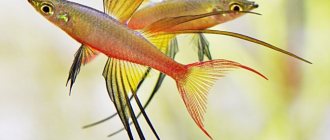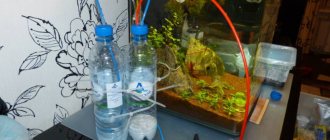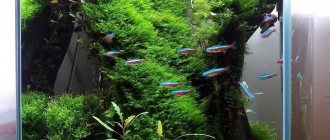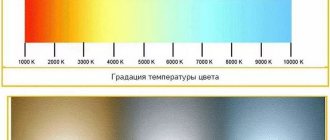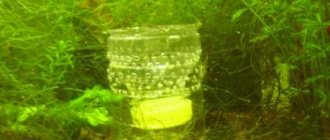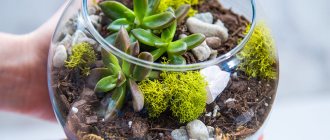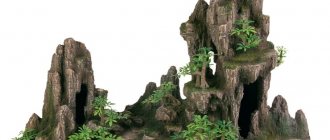In water or in air, but in pots
M.ZIRLING St. Petersburg
Aquatic plants are grown in different conditions and for different purposes. The vast majority of aquarists simply decorate their aquarium with them and do not set themselves the goal of obtaining a unique phytomonster or propagating hydrophytes on an industrial scale. At the same time, everyone wants to have a beautiful, healthy plant. There are many recommendations for solving this problem, but not always what is within the capabilities of experienced aquarists with the appropriate arsenal of knowledge is within the capabilities of a beginner. In particular, this applies to growing plants on nutrient soils.
Plants with a well-developed root system receive nutrients from the soil. Most typical aquarium plants are amphibians, and their feeding habits in water and air largely depend on the condition of the root system and the composition of the soil. Therefore, they require a complete substrate. Aquatic forms of plants (we call them aquarium plants) can receive nutrition from water, absorbing nutrients over the entire surface, so they tolerate some poor soil relatively easily. And with a significant number of fish (suppliers of organic matter) and timely water changes, most plants in the general soil feel quite tolerable: they grow, reproduce vegetatively and even bloom. But aquarists, naturally, want their plants to have the most attractive appearance and, even in extreme conditions, to develop as successfully as in optimal conditions. To do this, plants are planted in special soils with nutritional additives, which are produced by various companies.
Such mixtures are placed on the bottom and covered with ordinary neutral soil on top. They do not harm fish and can help in plant development. Please note - help! Since this only happens in a balanced aquarium, in water with the appropriate indicators, with well-organized lighting. And when the necessary conditions are not met, then feeding the plant is useless. This is the same as force-feeding a sick person: additional energy consumption and no improvement in his condition. It’s another matter when the patient begins to recover (in our case, when the plant takes root in a new place, because replanting is a painful condition). That’s when you need to feed as high-calorie and varied as possible. Thus, it is necessary to create nutrient soil very carefully and in a timely manner so as not to get the exact opposite effect of the desired one. But a novice aquarist cannot always assess the situation correctly.
Photo of aquarium plants in pots
In an aquarium where there are no mass plantings, individual plants can be grown in separate containers with nutrient soil. Most often, ordinary garden pots are used for this. The ratio of the diameter of the holes and the area of the walls of the pot is of great importance. Therefore, growing aquatic and hydroponic plants in special pots that come to Russia, usually from Holland, gives excellent results, since thanks to precisely calculated holes, their degree of permeability to aqueous solutions and gases ensures proper nutrition and respiration of the roots. If you make a pot from scrap materials (for example, from the bottom of plastic bottles), you need to cut off the protruding parts of the bottom so that 1x1 cm holes are formed. This will allow the developed roots to grow into the general underlying soil. And they will definitely germinate, because they are “stifling” in a plastic container. The height of a homemade pot should be approximately equal to its diameter or a quarter larger.
The composition of the soil placed in a separate container consists of several main layers. At the bottom there is a large drainage layer of about 2 cm. On top there is a fine drainage layer of about 1 cm. Nutrient soil is placed on it, which is a complex mixture of peat-containing garden soil, two-year-old compost and sand (approximate ratio 2:1:1). Sometimes clay is added here (preferably red ferruginous or blue Cambrian), marble or limestone chips, coniferous soil (it all depends on what is supposed to be grown in the pot). The plant is planted in this layer, and a 2-centimeter layer of pebbles is sprinkled on top. I use a different mixture. I lay white bog sphagnum moss on the substrate placed in the pot, then add coconut substrate mixed with AVA fertilizer. I place a small (1.5-2 cm in diameter) piece of porous limestone in the center. Sometimes I add red clay there too. I plant a plant in this mixture, cover it with a thin layer of sphagnum moss and fill it with pebbles to the top of the pot. In this form, the pot with the plant is installed in an aquarium or paludarium.
All. Now we can expect an excellent result. But it can be absolutely the opposite - the plant dies. What's the matter? Yes, the plant must be prepared for planting in a nutrient substrate. Very often you hear advice - trim the roots. But how to do it right? Let's try to figure it out. Rotten roots of a plant removed from the soil must, of course, be removed. An old plant constantly sheds some of its roots (as well as leaves), which rot in the soil and form a nutrient layer. In this case, the rhizome should remain completely healthy, without the slightest signs of rotting. It is better to purchase a young plant. The roots should initially be clean and healthy. And if you are replanting a plant in your own aquarium and see rotten roots, then remove only the easily separated parts and it is better to plant such a plant in poor soil.
Photo of aquarium plants in pots
You can trim healthy roots only if they are very long and would have to be twisted when planting. The roots should lie in a neat cone on a mound of prepared soil. Thus, the length of roots left should be equal to the radius of the pot. The laid roots are sprinkled with soil, which is lightly compacted with your fingers. It is very difficult to determine which part of the roots will die after planting. And this will certainly happen, since injury is inevitable during transplantation. Sometimes the roots are partially preserved during the first weeks - this makes it easier for the plant to adapt to new conditions. Typically the plant forms young roots within the first two weeks.
Aquariums - aquarium for beginners, aquarium for amateurs, aquarium for professionals
Most read
Many hobbyists often observe plants in aquariums planted in pots. These can be plastic, glass or ordinary ceramic pots. Unfired clay pots or wicker plastic “baskets”, partially or completely dug into the ground, or simply standing on the ground.
Why is this being done?
First of all, it is necessary to clarify that we are talking specifically about growing plants in a biotope in pots, and not about hydroponics or the germination of hydrophytes in the air. That is, instead of simply sticking the plant root into the aquarium soil, the hobbyist “sticks” it into a pot of soil.
The obvious advantage of this type of growing hydrophytes is the ability to rearrange the pots over the entire area of the bottom of the biotope, as well as hang them in different places in the container: hydrophytes planted in this way are very transportable. Indeed, if an amateur has decided to create a beautiful composition of plants, then the ability to maneuver them will be very useful.
Pots are also used if the plant is planned to be moved to another biotope, or transported and sold, and also if the plant has a very large root system that can “clog” a significant part of the soil area.
Most often, such pots are used to add nutritious soil to them.
If for some reason the aquarist does not want to add nutrient layers, or a large amount of fertilizer directly to the soil (for example, he is afraid of an outbreak of algae, due to the fact that there are not so many plants in the soil, or he simply does not want to waste his time on maintaining, measuring and adjusting various parameters of the general situation in a biotope with nutrient soil - it is known that this requires a lot of attention and time), then nutrients can only be added to pots. In this case, their concentration will be insignificant and will definitely not harm the entire biotope.
This planting method is also used for plants that require individual feeding, for example, weak or very expensive plants. At the same time, the pots themselves are often hidden by snags and creeping plants. Plants in pots are a solution for a biotope in which fish dig heavily. And the roots of these plants are guaranteed not to “suffer” when cleaning the soil with a siphon.
Disembarkation rules
Aquarium plants are planted in two ways:
- Planting is carried out in a substrate laid at the bottom of the tank. Filling with water is carried out after some time. This option is advantageous in that the root system penetrates deeper into the soil and is more firmly anchored.
- The plant is planted in a container filled with water. This method is used when planting those species that have long stems.
Mr. Tail explains: general rules for decorating an aquarium
After purchasing an aquarium, it is decorated, then liquid is poured in and aquatic inhabitants are released. If they want to change the design, the inhabitants are placed in a separate container along with water from the main tank so that they do not become stressed. After registration, the fish are moved in the reverse order with the same medium. All materials are disinfected to prevent diseases.
Photo gallery of decorated aquariums:
Some entrust the design to professionals, while others design it themselves using improvised or purchased materials. Secure objects with fishing line or cotton thread. You shouldn’t overfill the aquarium with a lot of decor; its inhabitants need space.
The main condition is that you need to take care of the tank: trim overgrown plants, clean glass and design objects. It is recommended to wash not with detergents, but with water and 5% vinegar or baking soda.
Main styles of aquarium interior:
- Dutch - no empty spaces are left at the bottom, there is a lot of vegetation, stones, and snags. Tall grass with wide leaves is placed in the background, low algae in the front.
- Collector - similar to Dutch. Only different plants are planted chaotically so that the aquarium looks like a neglected garden.
- Natural – there are stones, mini-trees, figurines of houses, “sunken” ships.
- Thematic - they decorate the tank according to some theme. It could be a story, a movie, a book, a cartoon.
- Avant-garde - the scenery consists of synthetic bright soil, plants, and unusual colors. Stones are used from natural materials.
- Biotope - similar to the structure of a natural reservoir. The same stones, plants, fish. Elements of the habitat and live fish are selected taking into account their natural ecosystem.
- Herbalist - all the beauty is in the varied vegetation of green shades. This can be a tank with only live and artificial grasses without fish.
Composing a composition
Select representatives of the fauna for the mini-garden, following these principles:
The question often arises of whether to choose an open or sealed (closed) container for certain types of plants. The first and second options have their pros and cons.
Plants will feel great in the right container
A variety of plants are used in the compositions in the florarium:
To summarize, we advise you to pay attention to the following plants:
Alocasia - beautifully shaped leaves with bright colors
Varieties of begonias with small leaves
Rejuvenating, or stone rose
Any small ferns
Cacti of many types
Saintpaulia, better known to us as violet
Capricious orchids in the florarium will require special conditions
Source
Decorated background design
A properly selected background design visually increases the space. If cichlids and goldfish do not get along with living plants, use mock-ups, decorative films and stick them on the outside of the back wall.
Before attaching the finished film, the surface is washed, wiped dry, and disinfected. Moisten the material a little and apply it tightly, removing liquid and air from under it.
A homemade background made from a sheet of foam plastic is often used. It’s easy to make: a piece is cut to the size of the wall and fired to form bulges (can be cut with a knife). This side is covered with cement, gypsum, alabaster. After drying, cover with gray or golden paint and secure with adhesive tape to the back wall inside the container.
Make the background yourself from polyurethane foam. Apply a layer of foam onto a sheet of polyethylene with a spatula. Stones and sand are poured for weight. After drying, a second, relief layer is formed. Then epoxy resin mixed with acrylic paints is applied. The structure is attached to the wall with glue.
Selection of soil and stones
When choosing soil yourself, you need to pay attention to its composition, color, and particle size. You can buy it ready-made in the store. For example, for gourami and angelfish you will need river pebbles, granite chips, and coarse sand. On sale you can find multi-colored primer - blue, green, red. Slides, rocks, caves, and grottoes are created from fillers.
Stones are taken artificial and natural, without limestone in the composition. The most suitable are basalt, granite, pebbles, quartz. Marble, tuff, and sandstone emit calcium salts, which makes the water hard. The material is first washed, cleaned of dirt, and boiled for 10-15 minutes to destroy bacteria and microorganisms.
Wooden decorative elements
Wood is popular as a decoration for a pond. For example, branches and roots of hazel, elm, maple, beech, ash. It is better not to take coniferous species, they rot and favor the growth of bacteria. Oak is also not suitable, it releases harmful substances in the water.
The selected piece of wood is cleaned of dirt and bark, then boiled for 30 minutes in salt water. Holes are made and the edges are burned. Keep the resulting product in cold water for a week, while changing the liquid every day. Fixed at the bottom.
The driftwood is steamed in a strong salt solution (2-2.5 kg and 10 liters of water) for three hours over low heat. Then they lower it to the bottom, tying a load, after 2-3 days the tree will become heavier and will not float up.
Artificial wood also looks realistic and is made from polymer resins.
Other decoration elements
The details for decoration are models of ancient buildings, castles, caves or natural materials.
Coconut
After purchasing a fresh coconut, remove the milk and pulp from it. The shell is used in the aquarium as a shelter for fish. But first it is boiled for 5-7 minutes. After drying, they make a house for the inhabitants of the reservoir. The villi on the peel are not removed; the fish gnaw them off themselves.
Ceramic products
Clay pots are often used for decoration. It is not recommended to buy Chinese products, they emit harmful substances. A substrate for the reproduction of individuals is created from ceramic jugs and cups. The edges of objects must be smooth and round so that the fish do not get hurt.
You can buy a grotto made of plastic, plastic, or make it yourself from stones. The fish love to hide there. The stones are glued together randomly, and sometimes a hole is simply made in a large cobblestone. They use driftwood to burn a hole into, glass bottles, and clay for modeling.
Plants
Natural plants revitalize the water container and release oxygen. They are classified into several types:
- Rooting in the ground, for example - Arrowhead, Hygrophila, Capsula, Tradescantia, Vallisneria.
Vallisneria
- The herbs in the water fill it with oxygen, and fish (Moss, Anubias, Bucephalander) hide in them.
Moss
- Plants with large leaves floating on the surface serve as spawning grounds (Eichornia, Wolfia, Duckweed, Limnobium). They protect the pond from excess sunlight.
Wolfia
- Groundcovers create a green carpet on the bottom (Glossostigma, Sitnyag).
Plants are selected depending on the type of fish. For example, Ferns and Arrow Leaf are suitable for Cichlids. Elodea for Gourami, Catfish - representatives with a good root system - Cryptocoryne, Echinodorus.
Semi-desert succulent in a candy bowl
This florarium with cacti and succulents is easy both to make and to care for. But it is unusually beautiful thanks to the combination of several types of cacti (gymnocalycium, echinopsis, milkweed, prickly pear) and stone rose - a plant called young.
A florarium with a semi-desert landscape in a vase is very beautiful and unpretentious
If you have the opportunity to use painted cacti, be sure to do so to add some color to the arrangement.
For this florarium, select several cacti and succulents
So, you will need:
A vase, plants, soil and expanded clay - everything you need for your semi-desert
Wash the vase in hot water, dry and degrease, then begin making the florarium.
Geometric garden
Nowadays, vessels of various complex geometric shapes are very fashionable - from a simple pyramid to a pentakisdodecahedron. They have many faces, and not always symmetrical and the same in size, which is why the figure takes on fantastic shapes. You can create such a vessel yourself, but you cannot do without certain special skills and tools. Therefore, it is better to buy a finished product and apply your imagination directly to creating a florarium in it.
READ Where is a cat branded and why is this procedure done?
Polygonal vessels are great for creating a florarium
Prepare a vessel, plants, moss, soil and tools
When choosing a container, decide immediately on which edge it will stand. The thickness of the soil layer and the number of plants that will fit in the florarium depend on this. The base of the composition - drainage and soil - should be no more than 1/4 of the entire vessel, and most importantly, its level should be below the hole in the container.
Design of marine and reef aquariums
For sea water, shells, corals, reef fragments, artificial shells, and models of sea animals are used. Color range – blue, blue, red, white. Add some plants and soil.
Reef are the most expensive tank compositions. They are based on a natural coral reef. Organisms create a picture of the oceanic underwater world, these are shrimp, crayfish, mollusks, starfish, fish. Lighting depends on the type of coral. To create salt water, buy special ready-made salt.
Lighting devices, filters, pumps, heaters are controlled using automatic timers.
Plants - tapeworms
Solitaire plants – due to their bright colors or unusual shapes, they captivate the eye . Use no more than 2–4 tapeworms, planted in separate bushes in different parts of the aquarium. Echinodorus (heart-leaved, Uruguayan, Blechera, “Ruby”) will look wonderful, striking with their variety of shades and sizes, as well as the huge size of the delightful nymphaeum water lilies.
Lotus water lilies of various colors will add splendor to the design. An absolutely unpretentious plant that takes root well even in soil poor in microelements. Planted both in the center and closer to the foreground.
An unusual plant is crinum wavy, for successful care it requires well-fertilized soil with a layer of at least 7 cm or a nutrient substrate. Especially in large aquariums (over 500 liters), floating crinum is very effective.
Reference! If you decide to decorate the underwater world with wonderful echinodorus, you need to take into account their rapid growth.
They need frequent pruning of side stems that shade the plants underneath them. Therefore, they should be protected from proximity to light-loving plants.
Aquariums up to 100 liters should not be filled with large-leaved and tall tapeworms; they will not leave space for the development of other vegetation. Opt for compact types.
A very easy to maintain plant, suitable for small aquariums Aponogeton curly . For aquariums up to 60 liters, you can choose a replacement for tapeworms among smaller specimens of the unpretentious Echinodorus parviflora. A wonderful decoration would be Barclaya longifolia in red color, a beautiful capricious plant that loves a lot of light.
